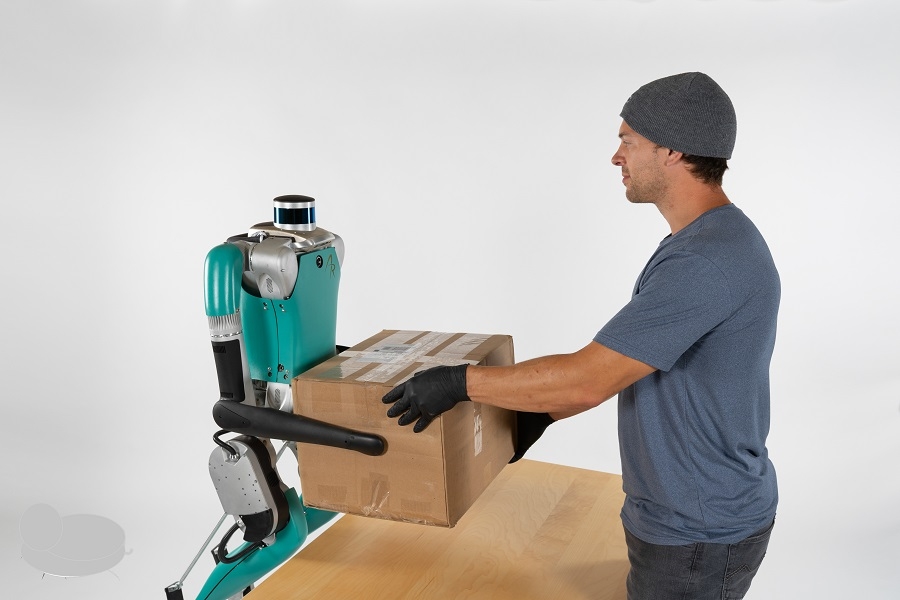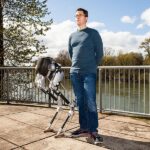Agility Robotics’ humanoid robot takes a pivotal step in commercial use.
If there is one thing every science fiction book, movie or television show can agree on, it is that robots will have a bigger role in everyday life in the future. Now, thanks to Albany-based Agility Robotics, that future has quietly arrived.
In 2017 the company premiered Cassie, a pair of robotic legs that could run and walk over all kinds of rough terrain. The robot was a breakthrough in engineering, and was purchased by robotics labs at universities across the country for experimentation and study.
Now, Agility Robotics has launched Digit, a robot that, as the name implies, has arms. The robot is capable of walking, and picking up and putting down objects. While that might not seem like much, the company has formed partnerships with four large companies, including Ford Motors, which intends to develop the robot for commercial use.
A Digit unit tranfers a box to a human recipient. Video by Agility Robotics
According to co-founder and chief technology officer Jonathan Hurst, this means that for the first time in human history a humanoid robot will be going to work.
While most of the names of the companies purchasing Digit units are confidential for now, Ford is interested in the application of the robot in autonomous vehicles, specifically parcel delivery. While this is still a long way off for robotics, Hurst says other practical applications are much closer.
Warehouse work is where he expects the robots to be used in the near future. Parcel delivery requires robots to interact with an unfamiliar and uncontrollable environment. Warehouse work, by contrast, requires the robot to work in a single controlled area. All that is needed is an environment designed with them in mind.
He anticipates a “big boom” in warehouse work due to the COVID-19 pandemic. Not only will more warehouse work be required, more automation will mean fewer humans coming into close proximity to one another.
While Digit can work in a warehouse designed for humans, modifications will need to be made to accommodate the mechanized workers. Hurst says that while putting robots in traditional warehouses is on the slate for now, facilities designed specifically for robots is the way of the future.
A Digit unit stacks boxes, simulating a warehouse routine. Video by Agility Robotics
“It’s going to be greenfield construction of robotic installations. I don’t see a future for legacy warehouses,” he says.
The robotic unit will need to be modified for each individual task, but due to its design Digits are built to be adaptable.
Agility Robotics has a “bio-inspired” approach to robotics, meaning it draws its inspiration from the movement of humans and birds. Not only can the robot’s arms pick things up, they also serve for balance and can right the robot if it falls down.
A Digit unit walks down the street of downtown Albany. Video by Agility Robotics
“When you solve one problem, sometimes you end up solving three or four more problems without realizing it,” says Hurst. “That doesn’t happen in other engineering, but it’s what happens when you’re imitating biology. We’re rediscovering nature in a way.”
Hurst credits a large amount of Agility’s success to Oregon State University, where he works as an associate professor of robotics. Without the university’s support, Agility Robotics might not be looking at the same bright future, says Hurst.
“Usually when something is developed, there’s a lot of squeezing blood from a turnip. Universities want to get royalties forever, which isn’t attractive to investors,” he says. “OSU is part owner of the company, so our goals align. That doesn’t happen at most places.”
The company is trying to raise new capital, which will go into new hires, many from Oregon State University’s robotics program. Agility Robotics plans to double its staff to 50 or 60 employees.
This is in preparation for what Hurst expects to be a large amount of growth and demand.
Service desk work could also be on the horizon for Digit units. A crucial element of robotics is the ease with which robots can integrate with humans. A challenge for designers is that robots cannot look too menacing, nor can they cross into the ‘uncanny valley,’ a point in design in which the robot appears too similar to human beings and thus appears threatening.
For that, human creativity is required.
A group of Berkeley engineering students solved this problem by giving a Cassie robot a pair of eyes in a style similar to the 2008 Disney-Pixar movie WALL-E.
Each Digit unit costs a company $250,000, with the parts manufactured at machine shops throughout the Willamette Valley. While production costs will decrease with scale, Hurst says the initial round of deployments will result in fixes, developments and the next model of humanoid robot.
“I compare us to Tesla. They made the roadster first. They didn’t sell a lot of them, but they leveraged up from there,” says Hurst. “That’s the game we’re playing.”
To subscribe to Oregon Business, click here.







